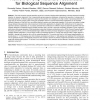Free Online Productivity Tools
i2Speak
i2Symbol
i2OCR
iTex2Img
iWeb2Print
iWeb2Shot
i2Type
iPdf2Split
iPdf2Merge
i2Bopomofo
i2Arabic
i2Style
i2Image
i2PDF
iLatex2Rtf
Sci2ools
TC
2010
2010
Network-on-Chip Hardware Accelerators for Biological Sequence Alignment
—The most pervasive compute operation carried out in almost all bioinformatics applications is pairwise sequence homology detection (or sequence alignment). Due to exponentially growing sequence databases, computing this operation at a large-scale is becoming expensive. An effective approach to speed up this operation is to integrate a very high number of processing elements in a single chip so that the massive scales of fine-grain parallelism inherent in several bioinformatics applications can be exploited efficiently. Network-on-Chip (NoC) is a very efficient method to achieve such large-scale integration. In this work, we propose to bridge the gap between data generation and processing in bioinformatics applications by designing NoC architectures for the sequence alignment operation. Specifically, we 1) propose optimized NoC architectures for different sequence alignment algorithms that were originally designed for distributed memory parallel computers and 2) provide a thorough co...
Bioinformatics Application | Information Technology | NoC Architectures | Sequence Alignment | TC 2010 |
| Added | 30 Jan 2011 |
| Updated | 30 Jan 2011 |
| Type | Journal |
| Year | 2010 |
| Where | TC |
| Authors | Souradip Sarkar, Gaurav Ramesh Kulkarni, Partha Pratim Pande, Ananth Kalyanaraman |
Comments (0)

